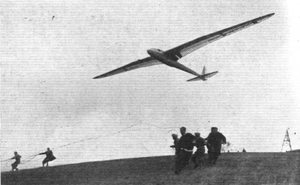DFS Fafnir
| Fafnir | |
|---|---|

|
|
| Type: | Glider |
| Design country: | |
| Manufacturer: | |
| First flight: |
August 10, 1930 |
| Number of pieces: |
2 (D-Fafnir and D-Sao Paulo) |
Fafnir was a high-performance glider that was developed by the German Research Institute for Glider Flight (DFS) .
With the further development of Fafnir II (also D - Sao Paulo ), Heini Dittmar achieved a world record flight of 375 km in 1934.
history
The aircraft was designed by Alexander Lippisch and designed by his assistant Hans Jacobs . The Fafnir became known through Günther Groenhoff's world record and alpine flights. The elevator was damaged in a failed rubber rope launch on July 23, 1932. The machine crashed and was badly damaged - Groenhoff was killed. On June 7, 1933, Peter Riedel flew a new route record with the repaired and slightly improved aircraft from Griesheim near Darmstadt to Vomécourt (France) with 229 km.
construction
The self-supporting shoulder wing had a two-part gusset wing with an auxiliary spar in front of the main spar. The fuselage had an elliptical cross-section and a normal tail unit with pendulum elevator. For the first time in a glider construction, the pilot's cabin was completely closed and provided with an aerodynamic plywood cladding up to the surface-fuselage transition. The pilot could only see through two side peepholes. After Günther Groenhoff's fatal crash on July 23, 1932, the aircraft was rebuilt with modifications. The wing connection was changed, the aerodynamic fairing was dispensed with and normal transparent cabin glazing was attached. Due to the use of a root profile with a very strong curvature (Gö 652 with 9% curvature stretched to Gö 535 with 5.8% curvature on the outer wing), the high-speed flight performance was not particularly good, but the circling properties in the thermals (also thanks to the gull wing) were for the Outstanding at the time.
Based on the experience with the Fafnir, Lippisch designed a significantly further developed machine in a middle-wing design with a faster wing profile. Particularly noticeable was the carefully constructed surface-fuselage transition, which reached far back on the fuselage. Heini Dittmar set the new world record for long-distance flights already on the first flight with this machine, known as the Fafnir II "D - Sao Paulo" .
The fuselage and tail construction of the first Fafnir also served as the basis for Dittmar's own construction, Condor 1 .
Technical specifications
| Parameter | Fafnir I. | Fafnir II |
|---|---|---|
| crew | 1 | |
| length | 7.76 m | 7.91 m |
| span | 19.00 m | |
| Wing area | 18.60 m² | 19.00 m² |
| Wing loading | 16.9 kg / m² | 18.4 kg / m² |
| Wing extension | 20th | 19th |
| Wing profile | Gö 652 / Gö 535 | DFS |
| Glide ratio | 20th | 27 |
| Slightest sinking | 0.76 m / s | 0.65 m / s |
| payload | 115 kg | 80 kg |
| Empty mass | 200 kg | 270 kg |
| Max. Takeoff mass | 315 kg | 350 kg |
| Minimum speed | 50 km / h | |
| Top speed | 220 km / h | 180 km / h |
Whereabouts
The aircraft was an exhibit at the Deutsche Luftfahrtsammlung Berlin and was destroyed in a bombing raid during World War II.
See also
literature
- Peter Ocker: Hans Jacobs - pioneering life in aircraft construction . Self-published, Heidenheim 2012, ISBN 978-3-00-039539-0 .
- K. Anders, H. Eichelbaum: Dictionary of aviation. Quelle and Meyer, Leipzig 1937.
Web links
- Fafnir in the J2mcL Planeurs glider database
- Fafnir II in the J2mcL Planeurs glider database
Individual evidence
- ↑ a b c d e Georg Brütting : The most famous gliders . 1st edition. Motorbuch-Verlag, Stuttgart 1970, p. 34-36 .
- ↑ luftfahrtgeschichte-darmstadt.de : 100 years of aviation in Darmstadt. Retrieved December 23, 2016

